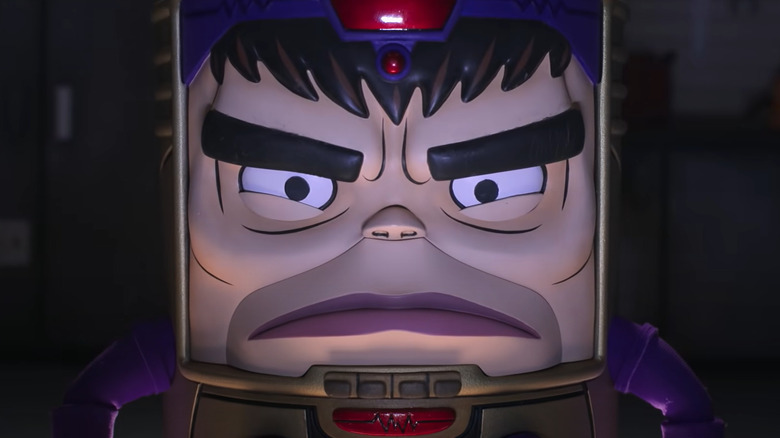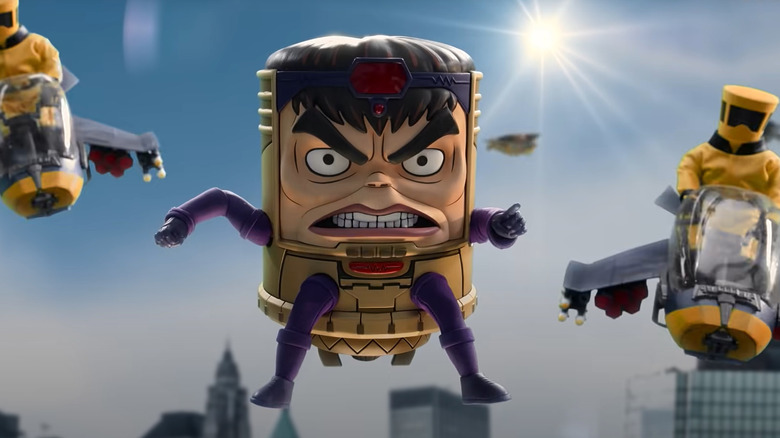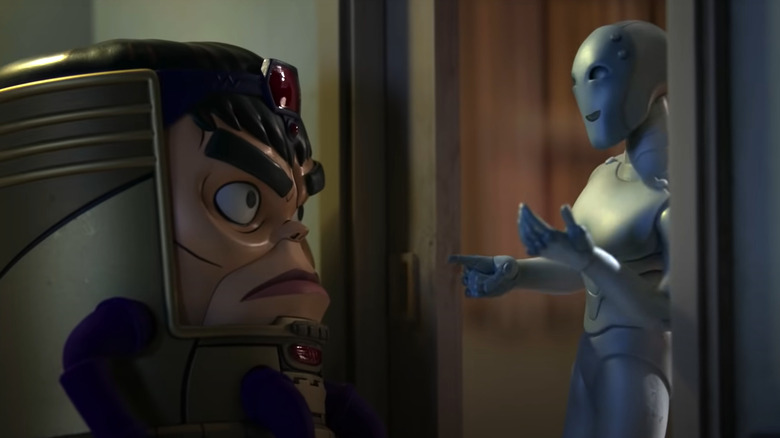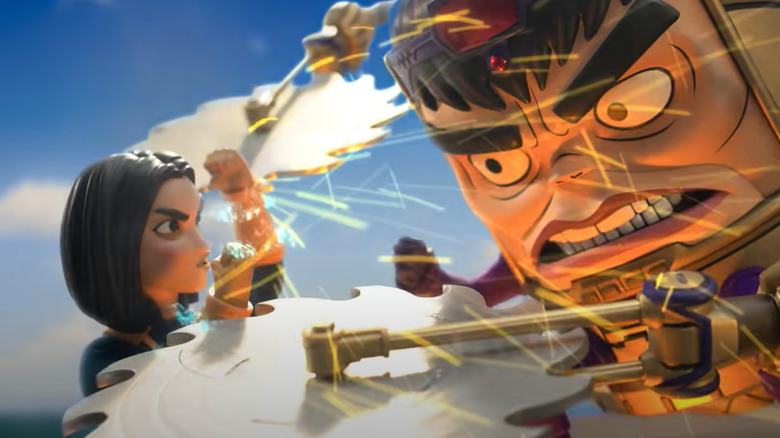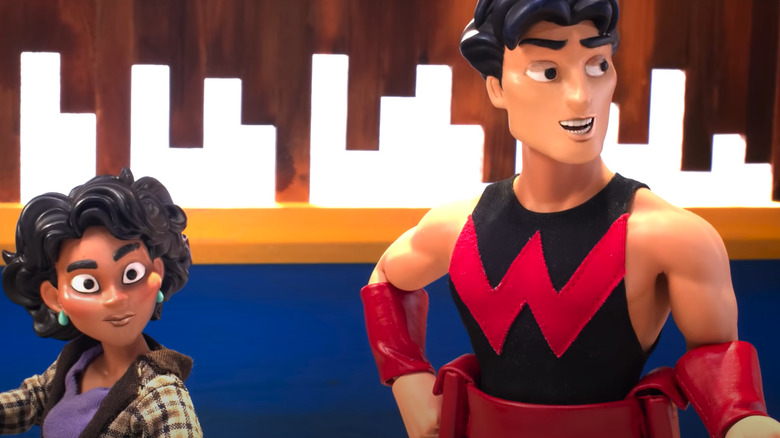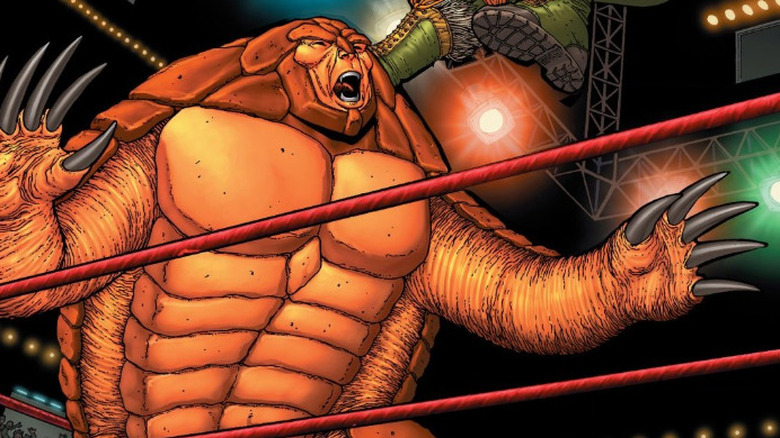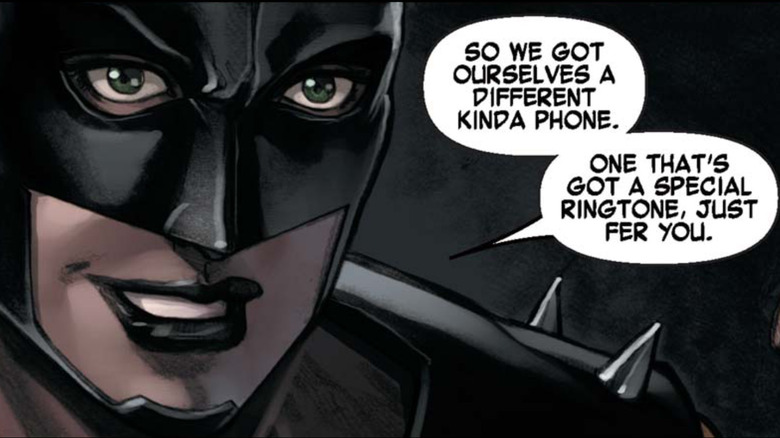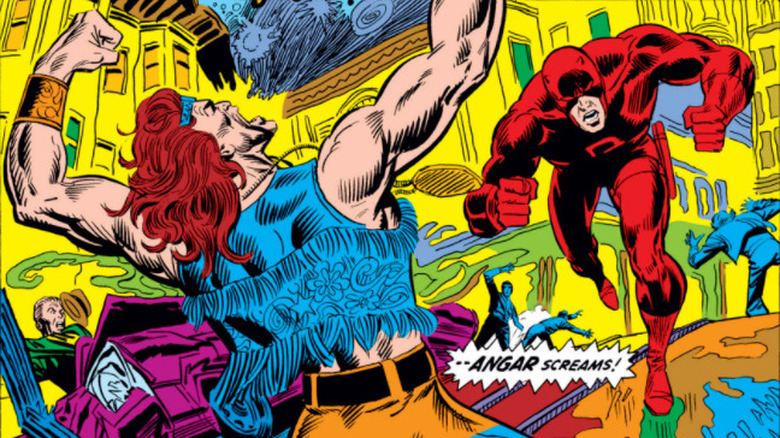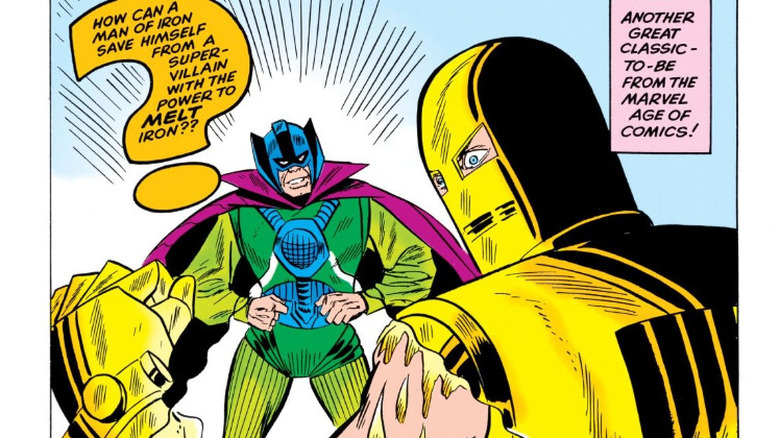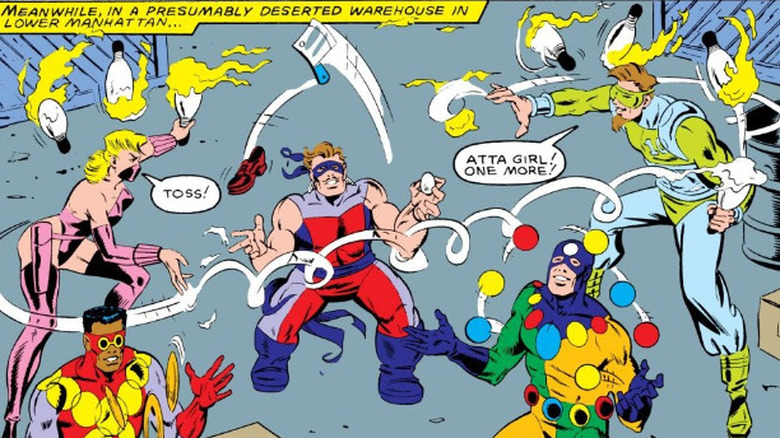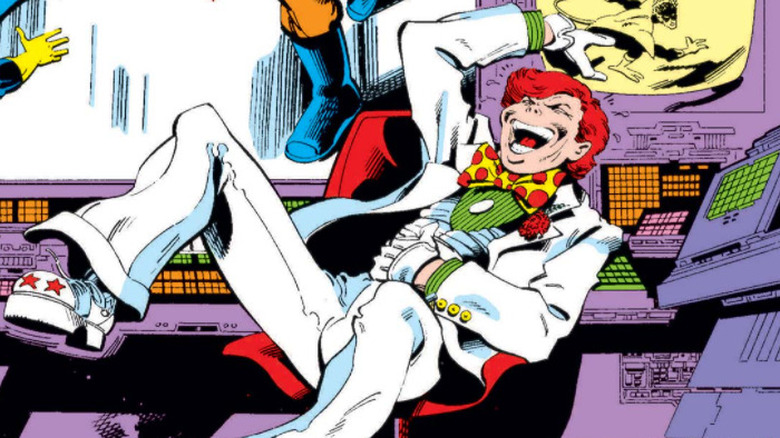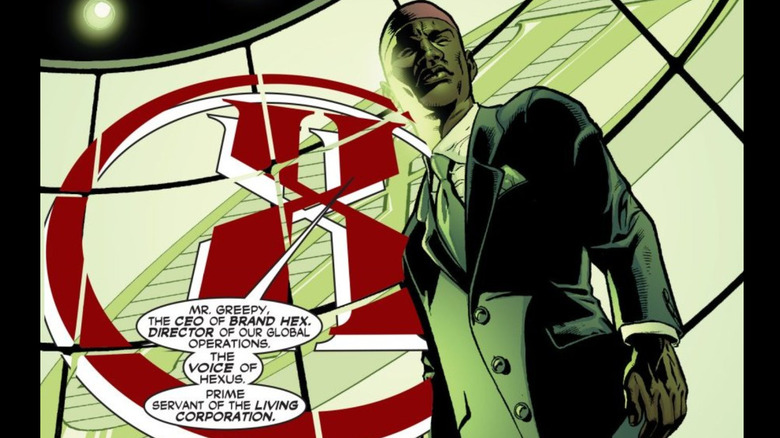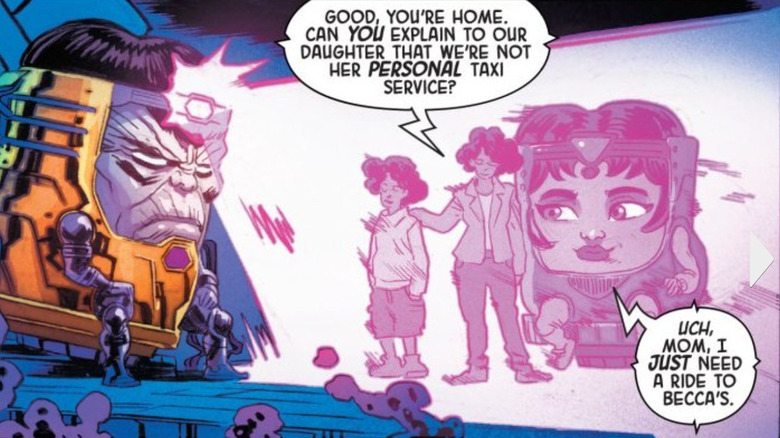Characters In MODOK That Are More Important Than You Realize
Hulu's new stop-motion animated show, "MODOK," co-created by and starring Patton Oswalt, absolutely delights in the use of obscure Marvel Comics characters. While their personalities usually don't match up with their comic book predecessors — particularly in the case of MODOK himself — even the ones you think can't possibly be actual Marvel references turn out to have some connection to the comics (looking at you, Mandrill) and while the vast majority of these are probably just one-off jokes or "MODOK" Easter eggs, some of them are prominent enough to warrant examination, especially when considering where the show might go from here in the event that a second season is ordered.
There are a few big names that do show up in "MODOK," but we're not getting into them here. Villains like the Leader and Mr. Sinister make brief appearances, but nothing that would lead us to believe they're going to have larger roles going forward, and the single most well-known character in the show, Iron Man, requires no more explanation. Instead, we're going to focus on major and recurring characters who are at least somewhat central to MODOK's narrative and who are obscure enough that they would benefit from a little context. And as a warning, we'll be spoiling basically the entire show, so if you haven't seen it and you want to be surprised, read no further!
MODOK
While you may not have heard of him before now, the hovering, big-headed super-genius MODOK has been a part of Marvel Comics since 1967's "Tales of Suspense" #94. He was originally a Captain America villain, but doesn't really belong to the rogues' gallery of any one hero — he's been involved in several Hulk storylines, and has frequently fought Iron Man, who the Hulu show casts as his arch-nemesis. It's a sensible choice — from the very beginning, MODOK has been associated with a group of evil scientists and weapons dealers called Advanced Idea Mechanics, or AIM, which was brought into the Marvel Cinematic Universe in "Iron Man 3." Beyond that, the fact that they are both genius inventors makes the two a natural pairing, and we would expect Iron Man to continue in the role going forward.
Of course, it should be noted that the MODOK currently hovering around in Marvel Comics — including the four-issue 2020 miniseries "Head Games" penned by "MODOK" creators Oswalt and Jordan Blum, which lays the groundwork for much of the show — isn't technically the original MODOK. That MODOK was changed back into his original human form, George Tarleton, during the "World War Hulks" event in 2010. The new MODOK, dubbed "MODOK Superior," is a cloned version, but nonetheless possesses Tarleton's memories. MODOK Superior is strongly associated with the popular but strange character Gwenpool, who also shows up in "Head Games," so a Season 2 appearance from her wouldn't be at all surprising.
The Super-Adaptoid
In "MODOK," Jon Daly's Super-Adaptoid is the comic relief character in the MODOK family, half inept butler and half annoying pet. As a result, it might surprise viewers to learn that the Adaptoid not only predates MODOK himself by a full year in Marvel Comics history, but was also a supervillain to be taken seriously. While the Hulu version seems to be just a shapeshifter and imitator, the Adaptoid in the comics could also appropriate someone else's superpowers, or even multiple sets of superpowers at the same time. It was powered by the Cosmic Cube — the comic book inspiration for the Tesseract in the MCU — and was a regular opponent of the Avengers, at one point becoming almost omnipotent before being defeated by Captain America.
The Adaptoid has been used semi-regularly in the comics since then, and there have proven to be multiple versions. This plot point comes up in "Head Games," which reveals that AIM's founder — and MODOK's original father — has an entire army of Super-Adaptoids hidden away in a small town in Ohio. The presence of multiple Adaptoids could turn out to be a Season 2 plot point, especially given how "MODOK" ends, and even the comic relief version has shown flashes of anger and traitorous behavior, perhaps hinting that it might one day need to be taken more seriously.
Monica Rappaccini and Carmilla Black
Another character closely associated with AIM, Monica Rappaccini (voiced by Wendi McLendon-Covey), is a villainous scientist specializing in biochemistry — a specialization seen frequently in "MODOK," most notably in the form of her bizarre experiments with manatees. The show initially depicts her as MODOK's primary underling before the two of them engage in a heated rivalry over who will be Scientist Supreme in the new AIM, a conflict that puts a hilariously mundane spin on their relationship in the comics. Since her first appearance in 2005, Monica has almost always been MODOK's direct enemy, constantly battling him for control of both AIM and the title of Scientist Supreme (though we do also learn about a brief romance that took place between the two). While MODOK often gets the better of her in the comics, the show portrays her as being his clear superior in both science and villainy.
Perhaps more interesting than Monica, however, is her daughter Carmilla, who makes a couple brief appearances in "MODOK." While she didn't do much in Season 1, the scorpion design on her shirt is a reference to the fact that in the comics, Carmilla is a superhero and SHIELD agent known as Scorpion, who has powers of toxicity provided by her mother's genetic experimentation. Scorpion and Monica are mostly enemies, but even if their relationship in "MODOK" remains intact, we have to assume Carmilla will assume a larger role in Season 2.
Wonder Man
Speaking of superheroes, another character with a somewhat larger role in "MODOK" is Simon Williams, aka Wonder Man, played on the show by Nathan Fillion. Wonder Man has one of the more bizarre narrative histories in Marvel Comics — first appearing in "Avengers #9" in 1964, he is given superpowers in order to fight the Avengers by the evil Baron Zemo, but ends up turning against Zemo to save the Avengers instead. Unfortunately, he also dies in the process, making him the rare character with decades' worth of continuity despite the fact that he didn't live through his debut issue. This is made possible both by the fact that his brainwaves were copied by Iron Man and ultimately used to create the Vision, and the fact that his body wasn't actually dead and would be revived multiple times before he finally, officially joined the Avengers.
Wonder Man is an interesting choice of Avenger for "MODOK" to use even in a limited capacity. He is famously conflicted about being an Avenger, often wondering if the team actually does any good and at one point leaving to become an actor. He would later openly lament his time with the Avengers and even form his own team to actively oppose them. We're not entirely sure what role Wonder Man might have in the future of "MODOK," but if the show continues to have an interest in themes of disillusionment and regret, a deeper look at the character might be warranted.
Armadillo
The fourth episode of "MODOK" sees the title character team up with five other low-level villains, who then show up sporadically for the rest of the season. It's unclear if anything about the show's future can be drawn from their inclusion, but they have a relationship with MODOK and more screen time than most of the other minor characters, so they're worth looking into, and probably the most notable is Armadillo — who, unlike the others, has comic book ties to MODOK.
In "MODOK," Armadillo is seen obsessing over his ex-wife, a reference to his comic book origins — he allowed the criminal scientist Karlin Malus to experiment on him, mixing his genes with those of an armadillo, if Malus would cure his wife's illness. Malus did so, but Armadillo would later go on a rampage after discovering she was cheating on him and he's been involved in various small-time villain shenanigans ever since. He was also a member of the Unlimited Class Wrestling Federation, a superhuman wrestling promotion. And most importantly, he was a member of the so-called "MODOK's 11," a heist crew put together by MODOK to steal a device called the Hypernova. Armadillo was one of the few members of the team who didn't betray MODOK.
Poundcakes
Another representative of the Unlimited Class Wrestling Federation is Poundcakes, voiced by Whoopi Goldberg. Originally a member of a four-woman wrestling team called the Grapplers who came into conflict with the Thing, Poundcakes would later be given superhuman strength and durability by the Power Broker Corporation, a company that offers superpowers for the right price. It was co-founded by the same Karlin Malus that gave Armadillo his powers — given the connection to both Armadillo and Poundcakes, it would make sense for Malus to appear in "MODOK" at some point, though that's far from a given. It would also make sense to see the other three members of the Grapplers, particularly Screaming Mimi, who had a lengthy career as a villain before adopting the name Songbird and eventually joining the Avengers. Poundcakes herself would also take a redemptive turn, recently becoming a supporting character in "The Unstoppable Wasp" — though she was present at the Criminal Technology Show Expo in "Head Games."
Angar the Screamer
Another connection to Screaming Mimi exists in the form of Angar the Screamer, voiced by Bill Hader. Beginning his existence as essentially an evil hippie in the pages of "Daredevil," Angar has sonic powers that he uses to cause hallucinations in the minds of others — though in "MODOK," his abilities appear to be more of the standard "sonic scream" used by characters like Banshee and Siren. He has some tangential connections to previous Marvel adaptions — he got his powers as part of a scheme to fight Thanos — but his most notable connection is his longstanding criminal partnership with Screaming Mimi. Angar's death would be the catalyst for Mimi rechristening herself Songbird and eventually becoming a superhero, even killing Angar again when he returned as the being of solid sound known as Scream. If Angar continues to be important in "MODOK," it would stand to reason that Songbird isn't far behind.
Melter
Okay, so Melter dies at the end of "MODOK" Episode 4, with MODOK's insistence that they were best friends coming up on several occasions. But he's still an instructive character when it comes to intuiting where "MODOK" might go next. Several of the characters we've looked at so far have been associated in some capacity with a group called the Masters of Evil, led by Baron Zemo. Zemo himself is probably not part of this conversation, since he's busy being played by Daniel Brühl in the Captain America-adjacent part of the MCU, but Melter is an original member of the Masters of Evil, and his presence might be the strongest clue in favor of something resembling that group showing up (another is the brief appearance of well-known Masters of Evil member Madame Masque). He's also, appropriately, the oldest character on this list, dating back to 1963, when he was introduced as an Iron Man villain due to his dastardly ability to melt iron.
Tenpin
Last and certainly least of MODOK's team, Tenpin is an extraordinarily obscure Marvel Comics character who is a member of a villainous team called the Death-Throws. Yes, really. The dubious brainchild of an evil juggler named the Ringleader, the Death-Throws are, in fact, entirely composed of evil jugglers, including Knickknack, Bombshell, and Tenpin's brother Oddball. (Again, we are not making any of this up.) Tenpin, naturally, uses bowling pins as weapons, though in the comics they don't explode (Bombshell is the one who juggles grenades).
It might seem strange to even mention Tenpin on this list, but to be honest, in a show like "MODOK," is it really more likely to see characters the comics take seriously, or characters that are already a ready-made joke? You laugh now, but you'll thank us when MODOK encounters a group of nefarious circus performers in Season 2, and you get to tell your friends what their names are.
Arcade
Tenpin might be a silly character, but when it comes to Marvel villain silliness involving sinister gameplay, there's nobody quite as wonderfully dumb as Arcade. Originally created by Chris Claremont in 1978, Arcade is a genius inventor (not unlike MODOK) who also happens to be thoroughly insane, and applies his considerable intelligence to the creation of elaborate deathtraps for superheroes, which they, of course, always escape. For fans of Marvel Comics, his appearance in "MODOK" is one of the highlights of the show, as the script hits us with one joke after another running down his ridiculous idiosyncrasies and self-sabotaging schemes. As an assassin who never manages to kill his targets because he insists on following the rules of his bizarre games (not to mention the giant pinballs) he has, until now, been an untapped well of Marvel adaptation comedy.
We're hoping Arcade sticks around in "MODOK" just because he's great, but there are also interesting directions the show could take with the character. The season finale of "MODOK" takes on a significantly more serious tone, particularly at the end, and if MODOK is allowed to be less funny and more evil, Arcade could do the same — particularly if the show takes inspiration from the "Wolverine/Gambit: Victims" or "Avengers Arena" miniseries, both of which, unusually, manage to sell him as legitimately and terrifyingly menacing.
Hexus the Living Corporation
Of all the all-but-unknown characters used in "MODOK," none are quite as obscure as Hexus, the Living Corporation. While the show's primary antagonist is a time-traveling version of MODOK himself, Hexus serves as a capable secondary villain, serving as the shadowy board of the company that purchases AIM. It's a sensible decision considering the modern themes of corporate acquisition and mobile communications culture that "MODOK" plays with, but it's also a staggeringly deep pull. In order to know who Hexus is in Marvel Comics, you would have to have read a single issue of "Marvel Boy" from October 2000, in which the series' Kree protagonist, Noh-Varr, must take down the swarming alien corporation before it consumes Earth. Written by the acclaimed Grant Morrison, "Marvel Boy" #3 provides a scathing critique of corporate capitalism by equating standard corporate activity with a plot to actively destroy the world. Ironically, by the time Noh-Varr fights it, Hexus is already threatening to topple Disney.
In light of this critique, it is perhaps unsurprising that Hexus has never been revisited in the pages of Marvel Comics, and unless Noh-Varr himself is going to make an appearance, there's not much speculation to be drawn from its presence in "MODOK." What the inclusion of Hexus does tell us, however, is that there's no character too small for "MODOK" to unearth and use as part of its narrative. If Hexus the Living Corporation can show up, anyone can.
Jodie, Melissa, and Lou
At first glance, there's no indication that MODOK's wife and children have roots anywhere in the comics. Comic book MODOK is not a bumbling loser in the grip of a mid-life crisis — he is a twisted, deformed villain, and he's certainly never had anything resembling a human family. That is, of course, until 2020's "Head Games," in which Oswalt and Blum took the opportunity Marvel had handed them in the form of writing a MODOK miniseries to introduce Jodie, Melissa, and Lou prior to the release of the "MODOK" show. Of course, in "Head Games," MODOK's family isn't real — his memories of them are simulated, part of a plan by his father. But by the end of the story, MODOK has defeated his father and used three members of AIM's army of Super-Adaptoids to create real versions of the family, which then join forces with him to bring down his enemies. If you think Lou can be trouble in the show, wait until you see a version of him with axes for hands.
What could this tell us about Season 2? Well, considering the show ends with MODOK having sacrificed his family in order to realize his dream of world conquest, the end of "Head Games" could foreshadow an attempt to duplicate them using the Super-Adaptoid, though we can't imagine that going well. What's more interesting in this case is the reverse effect — the fact that Marvel programming is now introducing new characters to Marvel Comics.
